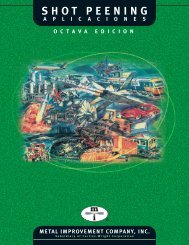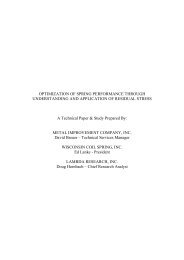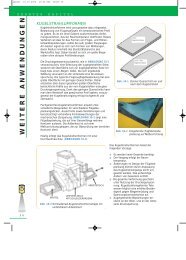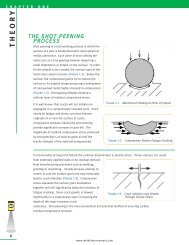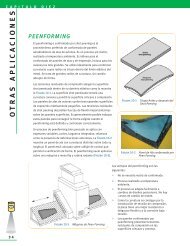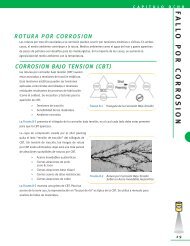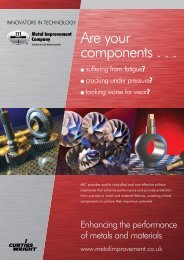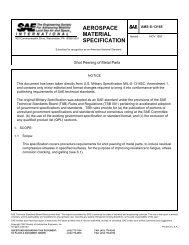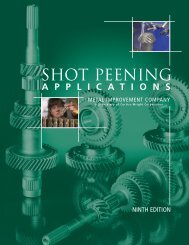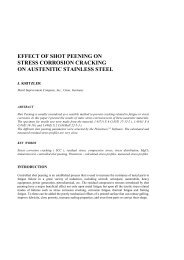Stress-lite Shot Peening of Compressor Reed Valve Components
Stress-lite Shot Peening of Compressor Reed Valve Components
Stress-lite Shot Peening of Compressor Reed Valve Components
Create successful ePaper yourself
Turn your PDF publications into a flip-book with our unique Google optimized e-Paper software.
" .<br />
The geometry <strong>of</strong> the reed is usually the first consideration and<br />
one over which the manufacturer <strong>of</strong> the reed has little control. Actually,<br />
the designers are much better served if they include the manufacturer<br />
at an early stage <strong>of</strong> the design. A manufacturer <strong>of</strong> reeds<br />
should not just be able to stamp out metal shapes: he must thoroughly<br />
understand all the factors that influence the life expectancy <strong>of</strong> a<br />
valve. For instance, the diameter <strong>of</strong> a mounting hole or the width <strong>of</strong><br />
a slot, within obvious limits, may have little influence on the efficiency<br />
<strong>of</strong> a reed but they can create difficulties for the reed maker<br />
that will impact both on the life and the cost <strong>of</strong> a reed. The reed<br />
maker must have a complete knowledge <strong>of</strong> materials; stresses (applied<br />
and residual; beneficial and detrimental); how life is affected by<br />
edge geometry, surface conditions, heat and corrosion; and the influence<br />
<strong>of</strong> bending, torsion and impact loads. Because his speciality is<br />
valves (and not compressors) the reed manufacturer can be <strong>of</strong> great<br />
value to the designer.<br />
The ideal valve reed would open fully and close totally in zero<br />
time: and last forever. We certainly are not there yet but an evolving<br />
technology, based on a more complete understanding <strong>of</strong> the many<br />
phenomena involved, is taking the best reed makers ever closer. We<br />
know that there are at least five areas that must be given attention:<br />
1. Choice <strong>of</strong> material, 2. stamped edges, 3. Removal <strong>of</strong> defects<br />
and detrimental stresses, 4. Edge rounding, 5. Depth and magnitude <strong>of</strong><br />
beneficial stress. We will address each <strong>of</strong> these items individually<br />
but it must be remembered that all are very much interrelated. For<br />
instance, maximizing #5, in theory would allow the use <strong>of</strong> thinner<br />
steel (#1) so that the reed would flex more and faster but maintaining<br />
flatness could then become a difficulty that would compromise the<br />
reed's ability to close totally. Overcoming this difficulty is the<br />
province <strong>of</strong> a good reed maker and much has been done in this area.<br />
Pursuing all <strong>of</strong> the above items to the maximum <strong>of</strong> current technology<br />
will produce a reed closest to the ideal. The extent <strong>of</strong> this pursuit<br />
is governed by the cost considerations <strong>of</strong> the application and the<br />
degree <strong>of</strong> efficiency that the designer wishes to obtain for the compressor.<br />
Designers need to be aware <strong>of</strong> the options available to them.<br />
Choice <strong>of</strong> Material<br />
There is much information published by the suppliers <strong>of</strong> valve<br />
steels and it is not our province to review it in detail. High carbon<br />
strip is the choice for thin reeds and is supplied and stamped in<br />
the pre-hardened condition .. Nickel-alloyed steel is usually used for<br />
thicker valves and hardened after stamping. Stainless is preferred<br />
for applications where corrosion can be a problem (Fig. 4, Ref. 6),<br />
such as in the presence <strong>of</strong> air, water or steam, dilute organic acids<br />
and sulphurous fumes. A corrosive environment will always lower fatigue<br />
properties, even in stainless steels, but the effect can be<br />
largely over come by the introduction <strong>of</strong> high residual compressive<br />
stresses.<br />
FIGURE 4. STRESS CORROSION CRACKING.<br />
Effect <strong>of</strong> shot peening with 40-80 m glass shot on the times to failure to<br />
type 304 and 347 stainless steels in a boiling 42% magnesium chloride solution~<br />
280r-----------------------------------------~<br />
ca. 240<br />
:E<br />
.n-<br />
Ul<br />
LrJ<br />
0:: 200<br />
~(/')<br />
0<br />
LrJ<br />
.J 160<br />
a.<br />
a.<br />
~<br />
120<br />
I<br />
10 100<br />
TIME TO FAILURE. HOURS<br />
0347<br />
® 304<br />
---<br />
not shot peened<br />
700



